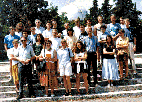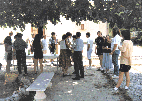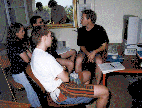(This text will appear in a forthcoming issue of the ESO Messenger)
The 5th ESO/OHP Summer School was hosted again at the Observatoire de Haute-Provence from 15-26 July. The school which has so far been offered biannually, selects 18 of Europe's most promising young doctoral students in astronomy. Courses of lectures, observations and analysis form the intellectual menu. These are aimed at the process of extracting astrophysically digestable results from photons harvested at the telescopes.
The OHP observatory is exceptionally well equipped to provide the ingredients of success for the school. The three main telescopes which are reserved for the students have state-of-the-art intstruments and detectors. The site is well placed to provide a proper mix of clear skies and other facilities (proper nourishment, other sustenance, access to recreation, etc). It is perhaps the other options which provide the ambiance which insures that the various items on the menu form a coherent whole and inspire the students, their tutors, and all around to pursue the tasks at hand with vigor and enthusiasm.
The basic ingredients for the school were unchanged from previous years. Students are formed (not divided) into groups of three, and each group is assisted by a tutor. The tutors helped the students prepare observing programs for both imaging and spectroscopy. The telescopes and instruments were prepared carefully according to the requirements of the programs, and the observations were performed, data were obtained and analyzed.
 (202 kb)
(202 kb)Figure 1 : As in past years, the official group photo is taken during the break in the talk by Ray Wilson. The organizers are still trying to explain this occurrence.
From left to right in the first row: Ray Wilson, M.-P. Véron,
K. Eriksson, V. D'Odorico. Second Row: A. Fishburn, W. Gacquer, O.
Barziv, N. Christlieb, D. Russeil, G. Dudziak, H. Gleisner, E. Pompei, C.
Laffont, and C. Moutou. Third row: P. Crane, T. Stanke, A. Mathieu, M.
Dennefeld, R. Voors, P. Royer, J.M. Perrin, J. Fynbo, S. Darbon, P.
Gooufrooij, L. Kaper, B. Geiger, H. Schmidt. Missing: Törben Böhm.
T. Böhm led C. Laffont, N. Christlieb and P. Royer in a study of Herbig Ae/Be stars. With the AURELIE spectrometer, they monitored such a star to look for spectral line variability of "active" lines which are a good indicator for the presence of a magnetically structured stellar atmosphere. At the 1.2m telescope, they observed a young open cluster in several coulours in order to classify the stars in the HR diagram.
D. Gillet led J. Fynbo, C. Moutou and E. Pompei in a study of the beta-Cephei star BW Vul in an attempt to distinguish between Stark broadening introduced by the passage of the compression wave and shock emission during the line-doubling phase. They used the AURELIE spectrometer to measure variations in the H-beta line. Their imaging project was to see if the small migrating bump reported in the light curve of XX Cygni is real or an artifact.
The group (O. Barziv, W. Gacquer and T. Stanke) led by P. Goudfrooij observed some S0 galaxies in imagery to study their (B-I) colour gradients and in spectroscopy, at the 1.93m telescope with CARELEC, to measure metallicity gradients, using the Mg_2 index.
S. Ilovaisky led V. d'Odorico, G. Dudziak and H. Gleisner in a search for an optical counterpart for ROSAT X-ray sources. They used the 1.2m telescope to obtain muti-colour images of the X-ray fields, in order to select possible optical candidates. Using CARELEC, they then obtained low-dispersion spectra of the candidates. The spectra were searched for peculiar spectral features which would identify the optical counterpart of the X-ray source.
Under the guidance of L. Kaper, A. Mathieu, H. Schmidt and R. Voors have tried to find out by imaging the field at H-alpha with a narrow band filter if the high mass binary Cygnus X1 is a run-away system with an associated bow shock. At the 1.93m telescope they have mapped a strong nebular emission line as a function of the distance from the blue variable star P Cygni.
J.-M. Perrin and S. Darbon led K. Eriksson, B. Geiger and D. Russeil in a search for extended red emission (ERE) fluorescence the compact HII region Sh 61. Initially interference filter images were obtained at the 1.2m telescope in order ot find the possible location of the ERE. Subsequently, low-dispersion spectra of these regions were taken with CARELEC.
The other major ingedient in the school was a series of invited lectures on topics related to observations, instrumentation, detectors, and other closely associated topics :
 (158 kb)
(158 kb)
Figure 2 : Relaxing, a cool drink, and earnest discussions
were the order of the day during breaks in the afternoon lectures.
 (137kb)
(137kb)
Figure 3 : Törsten Böhm explains the vagaries of data reduction systems
(or is it French keyboards?) to
Norbert Christlieb, Céline Laffont, and Pierre Royer.
All schools of this sort must end, and this one did too! On the final day, each group of students presented a summary of their results. Although the analysis techniques had for the most part just been learned, all groups presented interesting and in some cases potentially publishable results. This is no small achivevement considering that most people were entirely new to the scientific subject, the observing process, and the data analysis.
Although this school has not yet achieved the reputation of some other schools in France, the organizers thought that each student would nevertheless appreciate the "Cordon Lavande" they received and which certifies their achievements.
HTML version : S.A.Ilovaisky
15 September 1996